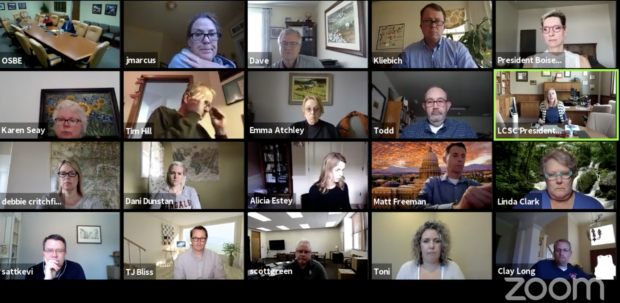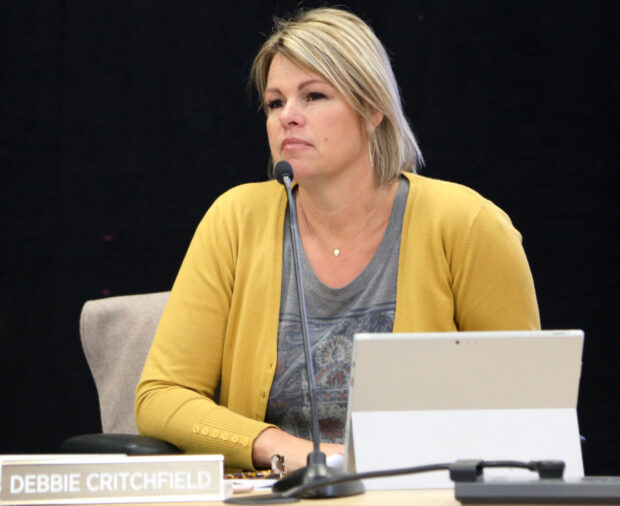
The State Board of Education issued a historic directive Monday to extend its statewide K-12 public school closure through the end of the academic year in an attempt to protect families and slow the spread of the coronavirus.
But, meeting Monday afternoon in a special virtual meeting, the State Board stopped short of an absolute order and included a giant caveat. Local school officials can re-open this year if local social distancing guidelines are lifted; if the school meets a list of criteria the board will present April 13; and if local health officials approve a reopening. The specific criteria for reopening has not yet been finalized.
“As long as we have any social distancing requirements, it’s hard for me to imagine a case where a school district could justify going back to school,” board member Kurt Liebich said.
Other board members pushed for as much flexibility and local control as possible.
“It’s important we give some consideration to areas in the state in which there is little or no evidence of the COVID-19,” board member Emma Atchley said. “There are still counties with no active cases. Some with very few.”
Some board members appeared to be reacting to an apparent slowdown in growth of Idaho COVID-19 cases over the weekend. On Monday, an Idaho Department of Health and Welfare spokeswoman told Idaho Education News local public health districts are not required to file daily reports on weekends.
State Board President Debbie Critchfield said the latest guidance and understanding of the fast-moving coronavirus pandemic is constantly changing.

“This has been a heavy burden for our board, frankly, and we don’t know what the right or wrong thing is,” Critchfield said. “Five years from now we’re going to know either we were geniuses or we didn’t do the right thing.
“Based on what we know now, and understanding that this is very dynamic and fluid, I feel good about this, it provides a pathway, or as Greg (Wilson) has referred to it an off ramp, for school districts to be able to make decisions,” Critchfield continued.
Superintendent of Public Instruction Sherri Ybarra supported the decision, saying local districts should retain options.
“This is a developing situation and local conditions do vary,” Ybarra said. “I said from Day 1 that districts need maximum flexibility for local decision making based on local decisions. Being that, I think it’s important to remember this is not just an education issue, or just a transportation issue, it’s really a health issue.”
Although physical schools will remain closed for the 2019-20 school year, remote learning is still expected to take place. Many districts are gearing up to launch online learning.
Others have sent work or have systems set up to pick up and drop off assignments.
The state’s largest district, West Ada, is gearing up to go online next week.
Many districts continue to offer meals for children, some operating as if they were running the Summer Food Service Program, others using the school bus to deliver lunch.
Although the situation is still unfolding, the statewide school closure may be unprecedented in Idaho.
“No one here can recall ever seeing mention of a statewide closure in any of the historical documents in this office,” State Board spokesman Mike Keckler wrote in an email to Idaho Education News.
Critchfield, Ybarra, Liebich and fellow State Board member Linda Clark also sit on Gov. Brad Little’s coronavirus emergency response team, which gave them access to daily briefings and the opportunity to ask State Epidemiologist Dr. Christine Hahn and other public health officials for guidance before making the decision Monday.
Although learning continues, the closure comes at a cost. That’s seven extra weeks of school closures beyond April 20 in West Ada, which scheduled its last day for June 2. Seven extra weeks of time that students aren’t spending in the classroom, engaging in group discussion, working on hands-on activities and receiving personal instruction from a teacher in the same room. Spring sports have been cancelled, as have many graduation ceremonies and other landmark rites of passage connected with schools.
Despite the extended closure, students are not being held back and will not be forced to repeat the current term, Critchfield told Idaho Education News on Friday.
Meanwhile, Ybarra and the State Department of Education have taken steps they said are designed to make this uncertain time more flexible for students, parents and educators.
- SDE officials are encouraging school leaders to submit waivers if their attendance has been affected, so that funding won’t be diminished.
- The State Board passed a motion Monday afternoon asking for Little to use his executive authority to waive instructional hour requirements, as well as requirements regarding the civics test and the Idaho Reading Indicator test.
- The State Board has waived certain graduation requirements, including the senior project for the class of 2020 and the requirement that this year’s juniors complete a college entrance exam.
- Ybarra announced the state has cancelled this month’s free SAT Day.
Schools across the state have been closed for weeks.
- March 14: The Blaine County and Canyon School District became the first large districts to announce they were closing school. Within a day or two, many large districts followed suit.
- March 15: Little declined to issue a statewide order to close schools, leaving it up to districts but urging school leaders to consult their local public health officials.
- March 23: the State Board issued its initial directive closing schools until April 20.
Click here to see our timeline.
While extending the closure through the end of the year resolves some uncertainty for educators, it sets up a situation where some schools could attempt to resume physical classes later this year while others do not. It also sets up a delicate give-and-take between Little and the State Board. Last month, Little declined to issue a statewide school closure, but he issued a statewide stay-home order in effect through 11:59 p.m. April 15. Now, schools won’t be able to reopen so long as social distance and self-isolation requirements remain in place.
